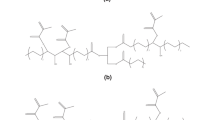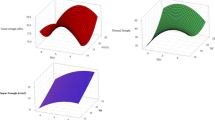Abstract
The goal of this study is to recycle diverse textile wastes and use them as cutting-edge and sustainable raw materials in composite structures. In the context of the study, vacuum infusion technology was used to manufacture epoxy and acrylated epoxidized soybean oil-based composites utilizing E-glass fabric and various textile wastes (denim fabric, pantyhose, and human hair). These hybrid composites’ physical (thickness, density, and fiber weight ratio) and mechanical (Charpy impact resistance, drop-weight impact resistance, and tensile and bending strengths) characteristics were investigated. While the results indicate that the hair-reinforced composites demonstrate superior damping capabilities with an absorption rate of 82% and absorb 16.51 J of energy, the polyamide reinforced composites with 204.68 MPa are the best substitute for E-glass reinforced composites in terms of tensile strength. Because of their poor fiber–matrix interface, cotton-reinforced composites performed the worst in all mechanical studies, with the exception of flexural strength. In many applications, where E-glass/epoxy composites are used, particularly in the construction or automotive industries, it is envisaged that sustainable composite constructions developed using waste fibers can provide an alternative.







Similar content being viewed by others
References
Tang Z, Li W, Tam VWY, Xue C (2020) Advanced progress in recycling municipal and construction solid wastes for manufacturing sustainable construction materials. Resour Conserv Recyl 6:100036. https://doi.org/10.1016/j.rcrx.2020.100036
Meng X, Fan W, Ma Y, Wei T, Dou H, Yang X, Tian Hu, Yu Y, Zhang T, Gao L (2019) Recycling of denim fabric wastes into high-performance composites using the needle-punching nonwoven fabrication route. Text Res J 90:695–709. https://doi.org/10.1177/0040517519870317
Lu L, Fan W, Meng X, Liu T, Han L, Zhang T, Dong J, Yuan L, Tian H (2020) Modal analysis of 3D needled waste cotton fiber/epoxy composites with experimental and numerical methods. Text Res J 91:358–372. https://doi.org/10.1177/0040517520944477
Keskisaari A, Kärki T (2017) Raw material potential of recyclable materials for fiber composites: a review study. J Mater Cycles Waste Manag 19:1136–1143. https://doi.org/10.1007/s10163-016-0511-2
Meng X, Fan W, Wan Mahari WA, Ge S, Xia C, Wu F, Han L, Wang S, Zhang M, Hu Z, Ma NL, Van Le Q, Lam SS (2021) Production of three-dimensional fiber needle-punching composites from denim waste for utilization as furniture materials. J Cleaner Prod 281:125321. https://doi.org/10.1016/j.jclepro.2020.125321
Islam S, El Messiry M, Sikdar PP, Seylar J, Bhat G (2020) Microstructure and performance characteristics of acoustic insulation materials from post-consumer recycled denim fabrics. J Ind Text. https://doi.org/10.1177/1528083720940746
Öztemur J, Sezgin H, Yalcin-Enis I (2021) Design of an impact absorbing composite panel from denim wastes and acrylated epoxidized soybean oil based epoxy resins. Text Apparel 31:229–234. https://doi.org/10.32710/tekstilvekonfeksiyon.910676
Hasret F, Agac S (2021) A sustainable design example: evaluation of pantyhose with bricolage and deconstruction method. Global J Arts Educ 11:71–88. https://doi.org/10.18844/gjae.v11i1.5726
Nanda BP, Satapathy A (2020) Thermal, acoustic, and dielectric behavior of epoxy-based hybrid composites using short hair fiber. J Braz Soc Mech Sci Eng 42:306. https://doi.org/10.1007/s40430-020-02398-z
Verma A, Singh VK, Verma SK, Sharma A (2016) Human hair: a biodegradable composite fiber—a review. Int J Waste Resour 6:1000206–1000206. https://doi.org/10.4172/2252-5211.1000206
Ansari AA, Dhakada SK, Agarwal P (2020) Investigation of mechanical properties of sisal fibre and human hair reinforced with epoxy resin hybrid polymer composite. Mater Today Proc 26:2400–2404. https://doi.org/10.1016/j.matpr.2020.02.513
Butt WA, Mir BA, Jha JN (2016) Strength behavior of clayey soil reinforced with human hair as a natural fibre. Geotech Geol Eng 34:411–417. https://doi.org/10.1007/s10706-015-9953-x
Sreevani G, Ajitha B (2017) Human hair as fibre reinforcement in concrete. Int J Eng Sci Comput 7:11358–11364. https://doi.org/10.1016/j.cscm.2020.e00412
Nanda BP, Satapathy A (2017) Processing and characterization of epoxy composites reinforced with short human hair. IOP Conf Ser Mater Sci Eng 178:012012. https://doi.org/10.1088/1757-899X/178/1/012012
Suman P, Lakshumu Naidu A, Ramana Rao PSV (2016) Processing and mechanical behaviour of hair fiber reınforced polymer metal matrıx composites. Int J Mech Prod Eng Res Dev 2016:469–478
Bakar MBA, Masri MN, Amini MHM, Thirmizir MZM, Salim MS (2018) Mechanical, thermal and morphological properties of epoxy resin toughened with epoxidized soybean oil. AIP Conf Proc 2030:020277. https://doi.org/10.1063/1.5066918
Wu Y, Li K (2017) Replacement of styrene with acrylated epoxidized soybean oil in an unsaturated polyester resin from propylene glycol and maleic anhydride. J Appl Polym Sci 134:450456. https://doi.org/10.1002/app.43052
Ozkur S, Sezgin H, Akay E, Yalcin-Enis I (2020) Hybrid bio-based composites from blends of epoxy and soybean oil resins reinforced with jute woven fabrics. Mater Res Express 7:015335. https://doi.org/10.1088/2053-1591/ab6892
Sanjay MR, Yogesha B (2017) Studies on hybridization effect of jute/kenaf/E-glass woven fabric epoxy composites for potential applications: effect of laminate stacking sequences. J Ind Text 47:1830–1848. https://doi.org/10.1177/1528083717710713
Arpitha G, Sanjay M, Senthamaraikannan P, Barile C, Yogesha B (2017) Hybridization effect of sisal/glass/epoxy/filler based woven fabric reinforced composites. Exp Tech 41:577–584. https://doi.org/10.1007/s40799-017-0203-4
Safri SNA, Sultan MTH, Saba N, Jawaid M (2018) Effect of benzoyl treatment on flexural and compressive properties of sugar palm/glass fibres/epoxy hybrid composites. Polym Test 71:362–369. https://doi.org/10.1016/j.polymertesting.2018.09.017
Nayak SY, Sultan MTH, Shenoy SB, Kini CR, Samant R, Shah AUM, Amuthakkannan P (2020) Potential of natural fibers in composites for ballistic applications: a review. J Nat Fibers 19:1–11. https://doi.org/10.1080/15440478.2020.1787919
Naveen J, Jawaid M, Zainudin ES, Sultan MTH, Yahaya R, Abdul Majid MS (2019) Thermal degradation and viscoelastic properties of kevlar/cocos nucifera sheath reinforced epoxy hybrid composites. Comp Struct 219:194–202. https://doi.org/10.1016/j.compstruct.2019.03.079
Ismail MF, Sultan MTH, Hamdan A, Shah AUM, Jawaid M (2019) Low velocity impact behaviour and post-impact characteristics of kenaf/glass hybrid composites with various weight ratios. J Mater Res Tech 8:2662–2673. https://doi.org/10.1016/j.jmrt.2019.04.005
Sumesh KR, Kavimani V, Rajeshkumar G, Indran S, Saikrishnan G (2021) Effect of banana, pineapple and coir fly ash filled with hybrid fiber epoxy based composites for mechanical and morphological study. J Mater Cycles Waste Manag 23:1277–1288
Taye Wondmagegnehu B, Paramasivam V, Selvaraj SK (2021) Fabricated and analyzed the mechanical properties of textile waste/glass fiber hybrid composite material. Mater Today Proc 46:7297–7303. https://doi.org/10.1016/j.matpr.2020.12.984
Prabhu L, Krishnaraj V, Gokulkumar S, Sathish S, Sanjay M, Siengchin S (2020) Mechanical, chemical and sound absorption properties of glass/kenaf/waste tea leaf fiber-reinforced hybrid epoxy composites. J Ind Text. https://doi.org/10.1177/1528083720957392
Kamble Z, Behera BK (2021) Sustainable hybrid composites reinforced with textile waste for construction and building applications. Constr Build Mater 284:122800. https://doi.org/10.1016/j.conbuildmat.2021
Ozkur S, Leskovšek M, Golja B, Demsar A, Sezgin H, Yalcin-Enis I (2021) Characterization of thermo-mechanical and morphological properties of jute fabric reinforced epoxy/AESO bio-composites. Fibers Polym 22:3414–3424. https://doi.org/10.1007/s12221-021-0201-0
Khan RA, Khan MA, Zaman HU, Pervin S, Khan N, Sultana S, Saha M, Mustafa AI (2010) Comparative studies of mechanical and interfacial properties between jute and e-glass fiber-reinforced polypropylene composites. J Reinf Plast Compos 29:1078–1088. https://doi.org/10.1177/0731684409103148
Makowski T (2020) Hydrophobization of cotton fabric with silanes with different substituents. Cellul 27:1–9. https://doi.org/10.1007/s10570-019-02776-4
Sunilpete MA, Cadambi RM (2020) Development of cost effective out-of-autoclave technology-vacuum infusion process with tailored fibre volume fraction. Mater Today Proc 21:1293–1297. https://doi.org/10.1016/j.matpr.2020.01.165
Abd El-baky MA, Attia MA, Abdelhaleem MM, Hassan MA (2020) Mechanical characterization of hybrid composites based on flax, basalt and glass fibers. J Compos Mater 54:4185–4205. https://doi.org/10.1177/0021998320928509
Chee SS, Jawaid M, Sultan MTH, Alothman OY, Abdullah LC (2020) Effects of nanoclay on physical and dimensional stability of bamboo/kenaf/nanoclay reinforced epoxy hybrid nanocomposites. J Mater Res Tech 9:8517–8527. https://doi.org/10.1016/j.jmrt.2020.03.114
Arun Prakash VR, Rajadurai A (2016) Thermo-mechanical characterization of siliconized E-glass fiber/hematite particles reinforced epoxy resin hybrid composite. Appl Surf Sci 384:99–106. https://doi.org/10.1016/j.apsusc.2016.04.185
Li X, He Y, Dong X, Ren X, Gao H, Hu W (2020) Effects of hydrogen-bonding density on polyamide crystallization kinetics. Polym 189:122165. https://doi.org/10.1016/j.polymer.2020.122165
Robbins CR (1994) Chemical and physical behavior of human hair. Verlag, New York
Evans GM, Jeffries R (1970) The swelling of cotton in cadoxen, ethylenediamine, and cuprammonium hydroxide. J Appl Polym Sci 14:633–653. https://doi.org/10.1002/app.1970.070140309
https://fibermakcomposites.com/tr. Accessed 03 July 2022
https://www.sigmaaldrich.com/TR/en. Accessed 03 July 2022
Saba N, Jawaid M, Sultan MTH (2019) Mechanical and physical testing of biocomposites fibre-reinforced composites and hybrid composites. In: Jawaid M, Thariq M, Saba N (eds) An overview of mechanical and physical testing of composite materials. Woodhead Publishing, UK, pp 1–12
Silverman EM (1987) Effect of glass fiber length on the creep and impact resistance of reinforced thermoplastics. Polym Compos 8:8–15. https://doi.org/10.1002/pc.750080103
Sanjay MR, Yogesha B (2016) Study on water absorption behaviour of jute and kenaf fabric reinforced epoxy composites: Hybridization effect of e-glass fabric. Int J Compos Mater 6:55–62. https://doi.org/10.5923/j.cmaterials.20160602.03
Khan GMA, Terano M, Gafur MA, Alam MS (2016) Studies on the mechanical properties of woven jute fabric reinforced poly(l-lactic acid) composites. J King Saud Univ Eng Sci 28:69–74. https://doi.org/10.1016/j.jksues.2013.12.0
Mili F, Necib B (2001) Impact behavior of cross-ply laminated composite plates under low velocities. Compos Struc 51:237–244. https://doi.org/10.1016/s0263-8223(00)00134-3
Selvakumar K, Meenakshisundaram O (2018) Mechanical and dynamic mechanical analysis of jute and human hair-reinforced polymer composites. Polym Compos 40:1132–1141. https://doi.org/10.1002/pc.24818
Balachandar M, Vijaya Ramnath B, Ashok Kumar S, Siva Sankar G (2019) Experimental evaluation on mechanical properties of natural fiber polymer composites with human hair. Mater Today Proc 16:1304–1311. https://doi.org/10.1016/j.matpr.2019.05.228
Ozkur S (2021) Investigation of performance characteristics of bioresin based textile composites. Dissertation. Istanbul Technical University, Istanbul
Oliveira FR, Steffens F, Holanda PSB, Nascimento JHO, Matsui KN, Souto AP (2017) Physical, chemical and morphological characterization of polyamide fabrics treated with plasma discharge. Mater Res 20:60–68. https://doi.org/10.1590/1980-5373-mr-2016-1032
Ekşi S, Genel K (2017) comparison of mechanical properties of unidirectional and woven carbon, glass and aramid fiber reinforced epoxy composites. Acta Phys Pol A 132:879–882. https://doi.org/10.12693/APhysPolA.132.879
Mortazavian S, Fatemi A (2015) Effects of fiber orientation and anisotropy on tensile strength and elastic modulus of short fiber reinforced polymer composites. Compos Part B 72:116–129. https://doi.org/10.1016/j.compositesb.2014.11.041
Khan MZ, Srivastava SK, Gupta M (2018) Tensile and flexural properties of natural fiber reinforced polymer composites: a review. J Reinf Plas Compos 24:1435–1455. https://doi.org/10.1177/0731684418799528
Author information
Authors and Affiliations
Corresponding author
Ethics declarations
Conflict of interest
The author declares that she has no conflict of interest.
Additional information
Publisher's Note
Springer Nature remains neutral with regard to jurisdictional claims in published maps and institutional affiliations.
Rights and permissions
Springer Nature or its licensor holds exclusive rights to this article under a publishing agreement with the author(s) or other rightsholder(s); author self-archiving of the accepted manuscript version of this article is solely governed by the terms of such publishing agreement and applicable law.
About this article
Cite this article
Yalcin-Enis, I. Evaluation of recycled textile wastes with E-glass fabric in bio-based epoxy matrix composites: investigation of the mechanical properties. J Mater Cycles Waste Manag 25, 171–180 (2023). https://doi.org/10.1007/s10163-022-01522-6
Received:
Accepted:
Published:
Issue Date:
DOI: https://doi.org/10.1007/s10163-022-01522-6




